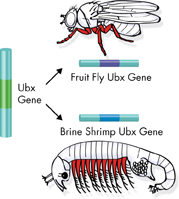Hox Genes and Evolution As you read in Chapter 13, Hox genes determine which parts of an embryo develop arms, legs, or wings. Groups of Hox genes also control the size and shape of those structures. In fact, homologous Hox genes shape the bodies of animals as different as insects and humans—even though those animals last shared a common ancestor no fewer than 500 million years ago!
 Small changes in Hox gene activity during embryological development can produce large changes in adult animals. For example, insects and crustaceans are related to ancient common ancestors that possessed dozens of legs. Today's crustaceans, including shrimp and lobsters, still have large numbers of paired legs, but insects have just 3 pairs of legs. What happened to those extra legs? Recent studies have shown that mutations in a single Hox gene, known as Ubx, turns off the growth of legs in the abdominal regions of insects. Thus, a change in one Hox gene accounts for a major evolutionary difference between two important animal groups.
Small changes in Hox gene activity during embryological development can produce large changes in adult animals. For example, insects and crustaceans are related to ancient common ancestors that possessed dozens of legs. Today's crustaceans, including shrimp and lobsters, still have large numbers of paired legs, but insects have just 3 pairs of legs. What happened to those extra legs? Recent studies have shown that mutations in a single Hox gene, known as Ubx, turns off the growth of legs in the abdominal regions of insects. Thus, a change in one Hox gene accounts for a major evolutionary difference between two important animal groups.

FIGURE 17–20 Change in a Hox Gene Insects such as fruit flies and crustaceans such as brine shrimp are descended from a common ancestor that had many legs. Due to mutations in the activity of a single Hox gene that happened millions of years ago, modern insects have fewer legs than do modern crustaceans. In the illustration, the legs of the fruit fly and the legs of the brine shrimp are the same color (red) because a variant of the same Hox gene, Ubx, directs the development of the legs of both animals.
Timing Is Everything Each part of an embryo starts to grow at a certain time, grows for a specific time, and stops growing at a specific time. Small changes in starting and stopping times can make a big difference in organisms. For example, small timing changes can make the difference between long, slender fingers and short, stubby toes. No wonder “evo-devo” is one of the hottest areas in evolutionary biology!
17.4 Assessment

-
Review What is a molecular clock?
Explain Why do molecular clocks use mutations that have no effect on phenotype?
-
Review How can crossing-over result in gene duplication?
Explain Describe how duplicate genes form.
Relate Cause and Effect Why is gene duplication important in evolution?
-
Review Use the evolution of the insect body plan to explain the significance of Hox genes in evolution.
Infer In evolution, why have small changes in Hox genes had a great impact?
VISUAL THINKING
The colored bands in the diagrams below represent mutations in a segment of DNA in species A, B, and C. Which two of the three species probably share the most recent common ancestor?

Table of Contents
- Formulas and Equations
- Applying Formulas and Equations
- Mean, Median, and Mode
- Estimation
- Using Measurements in Calculations
- Effects of Measurement Errors
- Accuracy
- Precision
- Comparing Accuracy and Precision
- Significant Figures
- Calculating With Significant Figures
- Scientific Notation
- Calculating With Scientific Notation
- Dimensional Analysis
- Applying Dimensional Analysis





